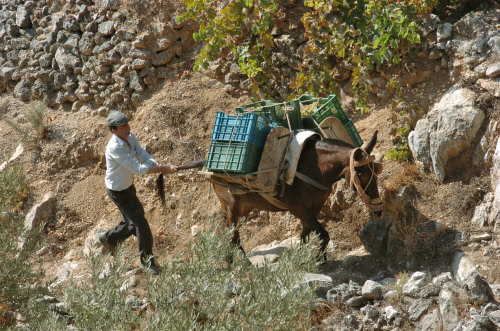|

OBTAINING
“MUST”
By definition, must is the juice pressed
from fruit, usually the grape, which is
fermented to make wine. However, there are
two localities in the Sierra de las Nieves,
Tolox and Yunquera, where the fermented
wine, ie, the finished product, is called
must. While in the past a number of mountain
villages engaged in the artisanal production
of wine in wineries and winepresses,
currently the craft is found only in the
areas of Tolox and Yunquera.

They are mountain vineyards, high up on the
mountainsides of the Sierra, where the use
of pack animals is essential for the
transport of grape to winepress. The “must
wine” of the Sierra is white, dry and of
high alcoholic content. The end of September
sees the start of the harvesting of the
varieties of white grape which are turned
into white wines after they have been
pressed and fermented. Until not so long
ago, pressing was done with esparto grass
sandals but, as in other times, it has been
adapted to the changes imposed by evolution.
Wine destined for distillation because it
lacks the right qualities for consumption is
called vino de quema (“burning wine“) and
there are good examples of stills which
distill the well-known brandies of Ojén and
Yunquera.

Despite their quality, the wines of the
Sierra de las Nieves never had the marketing
that they merit as the vintage is destined
for self-consumption or bulk sale. The
mountain vineyards suffered a serious
reverse at the end of the 19th century with
the phylloxera plague and unless policies or
guidelines (a regulatory body, promotion and
marketing, etc.) are adopted to put the
future of these wines on a different course,
they will end up extinct, remaining as
nothing more than a collective memory
witnessed only by the ruined walls of the
winepresses..
|